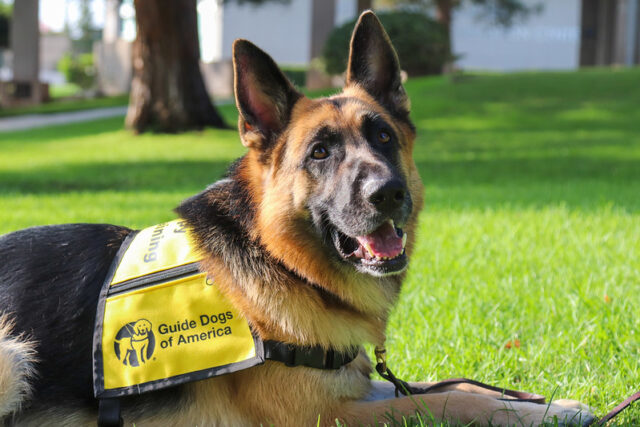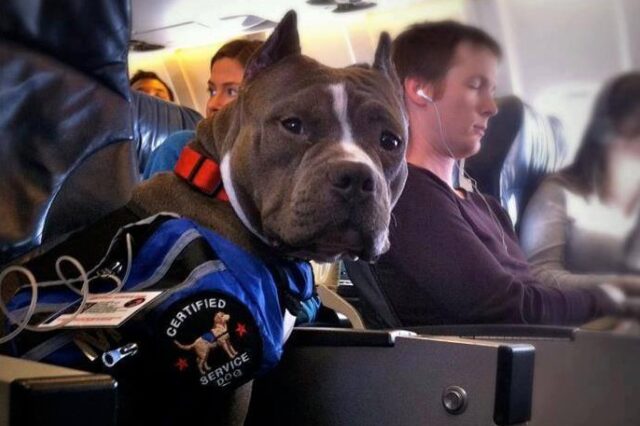Acquiring a service dog can be highly beneficial for people living with disabilities. Not only are these highly-trained pups able to help their handlers with physical tasks, but they also offer increased independence, as well as improvements in social relationships, self-esteem, and overall life satisfaction. Many people even report a decrease in anxiety, stress, and loneliness.
Unfortunately, the cost of qualified service dogs puts them out of reach for many people who need them. In this post, we’ll explore some of the available options for financing a service dog.

What is the difference between a service dog and an emotional support animal?
Service dogs undergo rigorous training—often from a very young age—to learn how to perform tasks for people with disabilities. They may learn to:
- Guide the blind
- Provide physical alerts for someone who is deaf
- Protect a person who has a seizure disorder
- Retrieve items for someone with mobility limitations
- Calm a person during an anxiety attack, and much more!
Unlike service dogs, emotional support animals do not require any specialized training.
Many people find the companionship of an emotional support dog comforting in times of stress. Some even find they help with anxiety, depression, and other mental health issues. However, emotional support animals are not considered service dogs because they do not have the same training. Therefore, they are not afforded the same privileges under the Americans With Disabilities Act, such as:
- Exemption from airline and hotel pet fees
- The right to enter stores, hospitals, schools, public transportation, and any other place open to the public
- Equal employment opportunities for the handler
RELATED: Blind Man Sues After Store Refuses His Service Dog Twice

How much does a service dog cost?
Service dogs often undergo years of specialized training which can add up cost-wise. A fully-trained service dog from a reputable organization can run anywhere from $15,000 to $50,000.
Fox Business offers the following breakdown of common expenses involved in getting a service dog:
- Fully trained service dog — $15,000 to $50,000, depending on how much intensive training is required
- Character test — $300 to $400 to see if your dog is a good service dog candidate
- Training — $150 to $250 per hour, for a minimum of 120 hours
- Ongoing veterinary care — $1,000 to $2,000 a year
- Food — $300 per year
- Service dog registration fees — $100 to $200
These figures do not include the cost of grooming services and supplies like toys, treats, collars, leashes, and other accessories.

What options can help make a service dog more affordable?
1. Grants for Service Dogs
Several nonprofit organizations offer grants to help people with disabilities obtain service dogs they may not otherwise be able to afford. You can find information on many of these programs via Assistance Dogs International. Below are a few additional options.
- The Seeing Eye breeds and raises puppies to become seeing-eye dogs for people with visual impairments. Students pay just $150 for their first dog and $50 for subsequent dogs. Military veterans pay $1.
- Canine Companions places service dogs with children, adults, and veterans with disabilities at no cost to approved applicants.

2. Health Plan Benefits
Regular health insurance does not cover the cost of a service dog, but you may be able to use funds from a health savings account (HSA) or flexible spending arrangement (FSA).
According to Fox Business, “both are tax-advantaged savings accounts that let you set aside pre-tax money to pay for qualified medical expenses. Funds from an HSA can roll over from year to year, while funds in an FSA have a “use it or lose it” policy, meaning any funds you don’t spend by the end of the year (plus a specified grace period, if your plan allows it) are lost.”
To be eligible for reimbursement for a service dog through an HSA or FSA, you should obtain a Letter of Medical Necessity from your doctor stating that you need a service dog for “the diagnosis, treatment, or prevention of a disease or medical condition.”

3. Personal Loans
Many people need service dogs, and it can take years to obtain one through a nonprofit organization or foundation. If you don’t want to wait, you can always buy or adopt a dog, then take out a loan to pay for training. When choosing this option, be sure to shop several lenders to ensure you get the right loan for you.
This is also a good option for those looking to obtain an Emotional Support Animal. Since ESAs generally don’t qualify for financial assistance, a personal loan can help cover the cost.

4. Fundraising/Crowdfunding
If you cannot afford a service dog, try reaching out to the community for help. Local events such as fun runs and bake sales can turn quite a profit for a worthy cause. There are also several sites for crowdfunding online, including GoFundMe, Fundly, and SpotFund.
RELATED: Family Is Raising Money To Get Service Dog For Autistic Son
5. Social Services
In some states or cities, the department of social services may be able to provide some financial assistance. In California, the Assistance Dog Special Allowance Program offers $50 a month to help service dog owners cover the cost of food, grooming, and veterinary care. It may not be much, but every little bit helps!
Featured Image via Instagram
